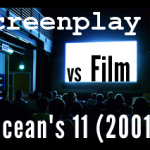Character introductions are an essential component of a well-written screenplay, and yet, they’re so hard to get right…that applies to the pros as well as to amateur screenwriters. For the past couple of weeks, I’ve been sharing the screenwriting tips I’ve learned by studying the differences between Taken’s screenplay and its produced movie.
In this post, I’m going to focus on some of the tips I’ve learned which specifically apply to introducing your characters, in particular the hero.
Taken, if you didn’t see it, stars Liam Neeson who “relies on his old skills to save his estranged daughter, who has been forced into the slave trade.” (Logline kindly provided by IMDB.) Although Taken is an action/thriller, these tips apply to all screenplays of any genre, so let’s get started, shall we?
Character Introduction Tip #1: Face to face is always best
Bryan and his ex-wife, Lenore have a contentious relationship to say the least. Lenore, now remarried, mocks his cautiousness and resents his stubbornness. Their clashes over how to best raise their daughter, Kimmy, are a huge source of screenplay conflict in the first act, and screenwriters Luc Besson and Robert Mark Kamen were wise to introduce this relationship early on, by page 4.
But how does this oh-so-important introduction to this contentious relationship take place? Over the telephone (!) instead of in person, where the audience can witness firsthand the sparks of tension.
Whenever possible, have your character interact face-to-face instead of over the phone, or through text message, or instant message, or whatever technology they develop next. You give the actors so much more to work with, when they’re in the same space, and the resulting scene becomes much more rich and textured. This screenwriting advice is especially important if you’re introducing a key character and/or relationship as was the case here.
It’s like dumping someone; you’re a coward if you do it over the phone or via text message. Real gentlemen and ladies duke it out in person…and so do real screenwriters.
Character Introduction Tip #2: Show, don’t tell
Just getting your characters into the same room doesn’t mean you’re home-free yet. There are other screenwriting snafus to fall into when introducing your hero or other main characters.
The most common problem is showing instead of telling. This is a screenwriting mistake that applies to a whole bevy of screenplay components, not just to introducing your hero, so getting out of this habit early on is key to developing your screenwriting skills.
In the following conversation between Bryan and Lenore, we’re told about two key facets of Bryan’s character instead shown that he has them.
We’re told Bryan is meticulous with details:
LENORE
You know, for a person who is such a stickler for details, you would think you’d read the invitation a little more closely. Two for her friends. Three for the adults.
We’re told he’s been an absentee dad:
LENORE
Bryan, you missed so many of the events in her life, what difference does an hour make?
BRYAN
(point of pride)
I’ve never missed a birthday.
These two details are really important. Knowing about Bryan’s meticulousness helps understand how he can track down Kimmy and find her, even though he has little evidence to go on. This gives the story more credibility.
Knowing about Bryan’s distant relationship with Kimmy is equally important because it makes us emotionally invested in his quest. We want Bryan to succeed, and we want it badly, because we want to see the rift between him and Kimmy repaired.
So how do you convey these details without having Lenore tell them to Bryan, who is well aware of his own deficiencies? Show them. That’s all.
It’s deceptively simple, but with practice, you’ll be a pro in no time. The interesting thing is that Luc Besson and Robert Mark Kamen DID show us these character traits in other scenes…making this conversation between Bryan and Lenore completely redundant. (More on that in character introduction tip #3.)
Here, we’re shown that Bryan is meticulous and obsessive:
Bryan walks over to a karaoke machine.
SINGH
You know if I charged you a dollar for every time you came in to examine the machine, you’d already own it…twice over.
BRYAN
I was looking over the manual and I noticed on page seventeen there is an auto record feature, but I didn’t remember seeing it…
Singh presses a button and a disc slot opens up.
We’re shown that he was an absent parent:
INT. BRYAN’S LIVING ROOM – DAY
Bryan is wrapping the Karaoke machine with a wrapping paper that reads young. Brightly colored, with balloons and confetti.
Clearly, Bryan is stuck in the past, when Kimmy was a young girl, and from this we can conclude that he doesn’t really know what she’s like as a teenager because he wasn’t around to witness her growth.
Here’s more proof:
LENORE
(bemused)
A karaoke machine?
The diminishing tone in her voice stings.
BRYAN
(apologetic)
I figured she wants to be a singer.
LENORE
When she was twelve, Bryan. We’ve moved on.
Bemusement mixes with a barely contained disdain.
KIM
Thank you Daddy.
And one more example:
KIM
I always used to ask mom what your job was that you were away all the time. She would tell me to ask you. But whenever I saw you, I was afraid to ask.
BRYAN
Why?
KIM
I don’t know. Maybe because I was afraid to find out. That it was something I wouldn’t like.
If you’re thinking that we’re shown that Bryan is absentee parent a little too much, then you’ll agree with…
Character Introduction Tip #3: Redundancy need not apply
When you’re writing your character introductions, you might be tempted to follow this post’s character introduction tip #2 too well and show multiple examples of how your hero has a certain trait or characteristic.
This is a really common screenwriting mistake. You want to nail down your hero’s introduction perfectly. You might be nervous, and the end result is you overthink it and overdo it…and end up boring the audience by showing them the same thing too many times.
Give them some credit. Don’t hit the audience over the head with your hero’s defining quality. Honestly, you don’t really have the space or the time because you’ve got a lot of ground to cover in your first act.
Here are few examples of how the screenwriters of Taken showed characteristics of Bryan one too many times, and which way they eventually ended up using in the final movie.
Bryan’s meticulousness/obsessiveness
In this post, you’ve already seen two different ways the screenwriters conveyed that Bryan is meticulous: Lenore told us Bryan was a “stickler for details.” Plus, we saw that Bryan basically memorized the manual for the karaoke machine he bought for his daughter.
Well, there was a third way too, which also involved the karaoke machine:
INT. BRYAN’S LIVING ROOM – DAY
He cuts the [wrapping] paper precisely, makes the corners match just so. As with everything else, he is meticulous. The way he folds it is unique, using no tape.
The filmmakers eliminated the wrapping paper scene (which is a double-whammy combo of telling and redundant showing), and as you know, he got rid of the conversation between Lenore and Bryan.
So in the movie version, we learn about Bryan’s obsessive attention to detail through his karaoke machine purchase. I think this was the best way because we saw how Bryan desperately wanted to choose the perfect gift in order to win over Kimmy’s affection. This created automatic sympathy for his character, because we’ve all been in that kind of situation.
Bryan is paranoid
One of Bryan’s stipulations to let Kimmy go to Paris is that she calls him the minute she lands, which of course, she does not. After checking that her flight arrived on time, Bryan calls her again and again, but she doesn’t pick up.
INT. BRYAN’S APARTMENT – NIGHT
Bryan is pacing, nervous. The clock reads two AM. He can’t take another minute. He picks up the phone, dials.
INT. PARIS APARTMENT – DAY
…CLOSE UP
On Kim’s handbag, sitting along with her luggage in the hall. Her cell rings and rings, cannot be heard over the blasting music.
This is followed by him calling Lenore to say that Kimmy isn’t picking up the phone:
INT. LENORE’S BEDROOM – NIGHT
The phone rings next to the bed. Lenore answers from a dead sleep.
LENORE
Hello?
INT. BRYAN’S APARTMENT – NIGHT
BRYAN
It’s Bryan. Did Kim call you?
INT. LENORE’S BEDROOM – NIGHT
LENORE
Bryan, she’s seventeen, she’s in Paris. Give her some space. She’ll call. Take a Xanax, have a drink. Good night.
She hangs up.
INT. BRYAN’S APARTMENT – NIGHT
Bryan stares at his phone.
BRYAN
Will you call, god damn it.
We get it, we get it: Bryan is paranoid (and as we’ll see later, rightly so). The second scene is completely unnecessary, and it was eliminated in the final movie.
Only the first scene was kept, which was a good choice plot-wise, because it showed that Bryan is paranoid without going overboard and his paranoia prepared us for when the abduction actually occurs.
Kimmy is a virgin
Lenore tells Bryan outright that Kimmy hasn’t slept with anyone:
LENORE
I gave it to her.
(beat)
Just in case.
(beat)
She’s still a virgin. Are you going to be able to save her?
BRYAN
First I have to find her.
And for the second time:
AMANDA
I hear French guys are amazing in bed. Maybe he has a friend…
KIM
No thank you.
AMANDA
You’ve got to lose it sometime. Might as well be in Paris! How cool would that be? Losing it in Paris. To an artist!
From the look on Kim’s face, not cool at all.
The second way is the way this information was revealed to us in the Taken movie. It’s much more natural, just two girls talking about their love lives and partying in Paris. The first way was so awkward and unrealistic.
Notice, too, that it is another example of Lenore telling Bryan (and the audience) something. No actress wants to be a mere expository device.
You might be wondering why it’s important for us to know so much about Kimmy’s private life. It’s not just so that Parisian-borne writer Besson could tout the bedroom skills of the French. In this clever way, he raised the screenplay’s stakes.
It’s a terrible thing to be abducted and then forced into the sex trade. You would think there could be nothing worse than that…but if you’re virgin, and that’s your first experience (and maybe your last experience), it makes a horrible situation even worse–and makes us even more invested in seeing Bryan succeed.
When you’re writing your own character introductions, and you’re weeding through the possibilities, evaluate the different ideas you have with these questions in mind:
- Does this scene accomplish more than one screenplay objective?
- Is it in keeping with the overall tone of my story?
- Do I need to write a lot of setup and/or backstory for my scene to make sense?
Answering these questions thoughtfully should help you select the best way to introduce your hero.
In some of these examples from Taken, you might think I’m being overly picky, because the redundant scene is only a few lines long. But if you’re desperately trying to streamline your screenplay, looking for–and then eliminating–these kind of redundant scenes can really help you out.
Plus, a busy reader in a hurry will appreciate that you’re not boring him with unnecessary repetition.
A really good example doing a trait introduction once and doing it right is the way the screenwriters showed us Bryan’s awesome martial arts skills as he saves the pop singer, Sheera.
In an instant, we know the level of his skill and the speed of his reflexes, both of which are important so that we can suspend our disbelief when the real action scenes occur in the second act.
You should always have a little bit of action in your first ten pages if you’re writing an action movie (humor if you’re writing a comedy, etc).
This “pop” of action probably could’ve happened sooner in the screenplay, and if you remove the redundant scenes I’ve pointed out, it would happen closer to the ten-page mark.
Character Introduction Tip #4: Use the power of the mighty anecdote
Here’s my final tip for ways to introduce your main character: use your other characters to tell an anecdote about him.
I know it seems like I’m contradicting the advice in character introduction tip #2.
Let’s examine this screenplay excerpt from Taken to see if I am:
BERNIE
Hey, you remember that time we were in Beirut after the Chief disappeared, and Bry was deep under with that crazy Sheik? The one who was gonna get us inside, and then he disappeared?
CASEY
And we’re sure your cover was blown and they were, like, pulling out your fingernails one by one.
SAM
And we’re scrambling to get the hell outta Dodge before we get taken down. And where the hell are you?
BRYAN
I promised her I would never miss a birthday.
SAM
That went down well at Langley when they found out you flew the coop to attend your kid’s birthday…nine thousand miles away. Where did you say your next posting was? The Arctic circle, spying on penguins, I believe it was.
BERNIE
Penguins are in Antarctica.
This is a pretty revealing anecdote about Bryan, and it’s a hybrid between showing and telling.
Bryan’s friends tell us information about him, but the key information, the character traits the screenwriters want you to know about Bryan are telegraphed indirectly through subtext.
Bryan’s friends don’t say explicitly, “Bryan will bend the rules when it comes to Kimmy,” or “Bryan will take on extraordinary risk when it comes to his daughter.”
Their anecdote tells us that, and because it’s not done explicitly, you’re not violating the “show, don’t tell” maxim.
Final thoughts
The screenwriting analysis in this post will help you to write your hero introductions. You might also find this post helpful, where I show you how to use a powerful college admission essay tip to write kick-butt hero introductions. For further study, you should also rent RED, an action-thriller laced heavily with comedy, which masterfully introduces all of its lead characters.
Character is only one-half of the equation however; plot is equally important to your screenplay. If you want to improve your plotting skills, study Taken’s screenplay structure. It’s a fast-paced thriller with no extraneous scenes, and its screenplay is a study in economy.
Hero introductions can generate some of the most memorable scenes in a movie, and they can be a lot of fun to write. So tell me, what are your favorite hero introductions?
Hello by Odd.note





















Comments on this entry are closed.
With regards to ‘redundancy need not apply’:
It can be hard to sense when something is redundant or not when you’ve read over your own script a million times; to an extent, everything feels redundant at that point. Having someone read it for you is clearly helpful at this stage, as I believe you mentioned.
However, how do you feel about allowing the script to be a little ‘overwritten’ or redundant in the early stages? In the Terminator 2 Special Edition behind the scenes with Jim Cameron, he talks about repeating information (specifically, the T1000’s ability to absord date through touch). He states that he ususally likes to leave it a little fat until he sees it onscreen and can better feel how quickly the audience is absorbing the information, leading of course to deleted scenes.
Do you feel, while in script stage, it’s better to have it and not need it, or need it or not have it?
Hi FilmKiller,
Great question! When you’re writing your first draft, I think the most important thing is to just get it DONE. It’s far easier to take a first draft, identify where it needs improvements, and make those changes than to work with nothing. Your first draft can be super sloppy or “fat”…although to avoid quite a bit of heartarche, I’d write your first draft from a script outline, so that at the very least, you won’t have to make major changes to your screenplay’s structure during the revising stages.
So in response to your question, in the first draft stage, allow your script to be a little “overwritten.” If you try to make it perfect from the beginning, you’ll only end up frustrated and will probably never even complete it.
You’re completely right; it is hard to spot redundancies – even for pros like Luc Besson and Robert Mark Kamen. But if you’re on the alert for them, they’ll be easier to spot, and that’s really what this post was all about: to prime your analytical eye as you revise your screenplay. That’s why I really wanted to include the text from Taken’s screenplay in this post. I was hoping that by seeing these examples, aspiring screenwriters might more easily recognize similar issues in their own scripts.
James Cameron has the luxury of showing a film to a real audience who can give him feedback…which we don’t have. So do the best you can without a live studio audience. If you’re really nervous or unsure, ask other writer friends to look at your screenplay or consider paying for a script consultant. You don’t even need to find screenwriters to evaluate your script – story logic comes naturally to mostly anyone (hello armchair critics!). Find someone who likes you a lot and ask them to listen to the beats of your story. Ask them to tell you when they’re confused or when they think something is redundant. Then you’ll have a good idea of where to put more explanation in…or take some out.
By the way, listening to the DVD commentary on your favorite movies is one of the best ways to get a screenwriting education. Plus reading posts on Scribe Meets World of course! 🙂 You most definitely do not have to get a film school degree to write a good screenplay, although a degree from USC, UT, or Ithaca College certainly increases your industry network.
PS I’m sorry it took so long to post your comment – weeding through spam is no fun!
Well, I’ve actually got five completed screenplays that I don’t know how to get viewed and/or produced. I finally buckled and entered Coppola’s Zoetrope screenplay competition *fingers crossed*.
I’ve heard of another technique that I’ve not had the pleasure to yet employ, which is to get local actors to do a read-through to help get a sense of flow (and I’m sure redundancies would rear their ugly head here as well). Have you employed this technique? Found it useful?
Regarding DVDs commentary, I’ve watched many movies more times with the commentary than without. =)
Of course, any advice on reaching “the people that matter” with one’s script would be welcomed. Thanks for your consideration and don’t worry about the response time.
If you’ve already completed 5 screenplays, that’s half the battle. Because of your practice, your writing skills should be a lot better now than when you first started. Plus, according to the 80-20 rule, one of those five could be the one to get your screenwriting career started!
Reaching “people that matter” would make a great post. I’ll try to write one in the near future. Michael Hauge’s Selling Your Story in 60 Seconds is a great resource. (I am an affiliate for this book, but I wouldn’t recommend it unless I believed in it.)
Hauge’s method is all about pitching your idea either through cold calling, pitch fests, or query letters. Competitions work too – and I hope you get good news in February from Zoetrope! (Why did you finally “buckle and enter?” It seems like you were reluctant to enter the competition, and I’m curious as to why. If you don’t want to explain, that’s okay. We’re all about personal liberty here!)
In terms of exposure and prestige, the best competition to enter is the Nicholl Fellowship — it’s run by the same people who give out the Academy Awards. A little caveat: they don’t seem too fond of commercial concepts. If you write indie-style films or period pieces, I think you’ll fare a lot better than if you submit a contained thriller or a romantic comedy.
I’ve recently learned about a nifty competition put out by the Writer’s Store called the Industry Insider contest. You only have to write 15 pages based on a logline provided by an A-list screenwriter, and then they select 10 finalists who get feedback & mentoring as they complete the rest of the screenplay. The winner gets to stay at the Chateau Marmont (swanky!), lunch at the Ivy with an A-list screenwriter, and a meeting with a management company. Robert Mark Kamen, writer of Taken, was actually the A-list screenwriter for the latest competition and Benderspink was the management company. It’s an interesting twist to screenplay competitions and I’ve been meaning to write more about it.
I haven’t used local actors to do a read-through, although I have heard it’s a great technique and something they do in pre-production as well. I can say though that if you’re looking for a bunch of actors who might do a read-through in exchange for a free meal, make friends with the actors’ groups at a nearby college/university. They might appreciate the experience, will definitely appreciate the free meal, and you’ll get the feedback you need…plus, if any of them make it big, you’ll have friends in the industry. It’s a win-win!
“Buckle and enter” =)
It had a lot to do with feeling weird about paying someone to give me the time of day – to read my screenplay. As per your 80-20 article, I DO feel like I deserve to get paid for my skill as a screenwriter (I’ve also written a film history column for about a year and over three hundred reviews for an online film site), and paying someone money I don’t really have (with copywriting and entrance fee I believe it ballparked at $200). I was also overwhelmed by the sheer number of competitions (surely SOME of them MUST be scams), and I’d be lying I didn’t acknowledge a little fear. I don’t care so much about winning, but what to do if all four entered (the fifth, or shall I say the first, needs some rewrites) garner no attention?
Lastly, I’ve been laboring towards producing one of the scripts myself (which I wrote deliberately low-budget; room with a view and a staircase) and holding out hope that selling any of them outright may not be necessary (as I’m probably even more passionate about directing than writing). In the end I chose to enter to get the ball rolling, Zoetrope because there’s a name I ‘trust’ associated with it, as well as the fact that it was a competition for beginners; I felt more confident about standing out.
I was further inspired by Michael C. Martin’s success in penning Brooklyn’s Finest.
Well FilmKiller, I’m glad you took the plunge! Zoetrope is definitely legit, so it’s a good one to take your chances.
If none of your scripts garner attention, it could be that your ideas aren’t in alignment with the contest judges (like I said rom-coms & thrillers don’t fare well in the Nicholl Fellowship) or that you need to work some more on your craft…or both. But don’t give up. Persistence is truly half the battle, maybe even more than half!
Producing your own script is also a great way to break-in, and generate some buzz, plus you develop more skills that will help you in the industry.
Good luck and please let us know about your success!